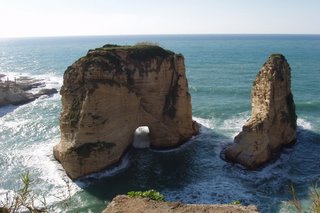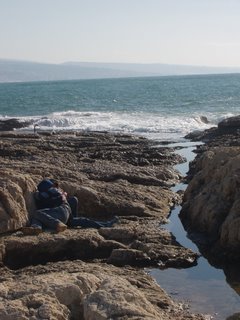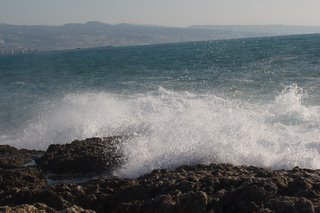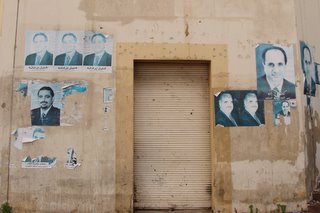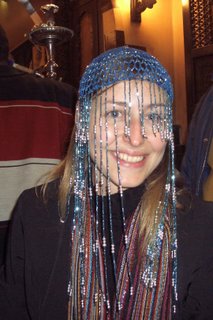
I ended my year in a strange hostel in downtown Cairo, having a laughing fit with a good friend and desperately trying to close my eyes, knowing my closest friends at home were just heading out the door for their New Year’s Eve adventures.
And so it’s a new year. How does it feel?
It hurts. And not in that usual post-New Year’s Eve sort of way. It’s my legs. I can’t move. Sunday morning Rob and I hobbled our way down to the street from our hostel and over to the Egyptian Museum. We alternated between wincing, aching and laughing at our own state of disarray as we struggled up the stairs to the first floor (European system) exhibits.
Apparently climbing hunched over down the narrow shaft of a pyramid exercises different muscles than any of our normal activities. Mix that in with riding camels and you have yourself a recipe for agonizing soreness of unanticipated proportions. We are a disaster. So there is your caution, pyramid-goers beware.
I saw my first pyramid on Friday, we actually went to explore two of the less famous ones (dubbed the ‘red’ and the ‘bent’ pyramids). There are around 90 pyramids in the upper region of Egypt, but of course the three most famous are the ones you always see, at Giza with the Sphinx herself. The two we visited first were built earlier and were basically the initial attempts as people slowly discovered the proper way to build the pyramids. The bent pyramid is exactly that, as it was being constructed the builders realized the initial angle of construction was too steep and would collapse. In an effort to adjust, the angle was altered halfway through the process from around 54 degrees to about 43 degrees, resulting in the ‘bent’ and imperfect shape you can see now.

I have found myself having a particular affinity for this one. Can you image all the hard work, resources and people it must have taken to construct? The entire structure serves as a reminder of the hard work and dedication it takes to succeed, and is the embodiment of the old adage "If at first you don’t succeed..."
The red pyramid is built in the earlier style with a stepped exterior created by the stacking of the original stones. It is often referred to as the first ‘true’ pyramid and is the third tallest in Egypt. It is called the red pyramid because of the supposed red stones at the entrance (although we didn’t think they looked all that red). In later years, limestone was added to the exterior of the pyramids to create a smooth surface along the entire outside of the structure, but this one was constructed before that technique was employed.
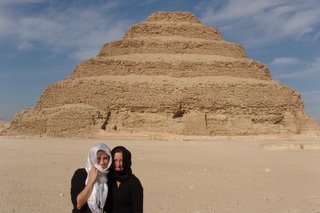
Walking up to the pyramid, we climbed stairs to the opening and began the descent down into the inner chamber. The passageway required you to crouch down with your legs bent until your chest almost touched your knees. They have installed footholds, arm rails and lights along the shaft and I cannot imagine what it would have been like entering that space for the first time with no light. As we made our way down the temperature began to rise and we could feel the air becoming increasingly stagnant. As we neared the bottom the air began to smell and the shaft opened into a large room.

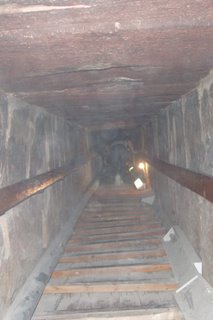
In that room the ceiling was constructed to look like the inverted pyramid, although the room was much too small for that to be true. It had neat angles and a huge staircase that led up to another smaller room that contained the burial chamber. The smell inside was intensely putrid and stifling. Between the smell and the heat, I kept alternating between placing and removing my scarf from my face, and the air was probably pretty contaminated (as you can see by all the particles that showed up when we tried to take pictures, it looked clear when we were standing there!)

The next day we went to the famous Giza pyramids. They are an amazing sight to behold and the Sphinx is just strikingly fascinating. I only went inside the middle pyramid. It was actually easier to enter and better ventilated than where we had been the day before, but was basically a similar, though easier, climb in to a chamber that leads to the tomb. The rooms were simpler and there were a few other passageways but they were all closed off.
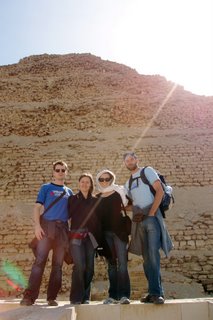
We all met in the afternoon for camel rides, which was entertaining. Their movement is much more awkward than the gaits of a horse and you are so much farther up in the air! We had an interesting band of camel drivers and mine was incredibly friendly almost to a fault, although it did get us into a camel race and I have to say I’m glad I did it although I would take a horse over a camel any day.

On the way back to the city we went straight to the docks and hired a boat to take us out onto the Nile for sunset.
Now while this all may sound like a wonderful adventure, and it was a great trip, I have to say it was also one of the more shocking, frustrating and aggravating experiences of my life as well. Cairo is a loud, polluted city filled with people trying to get your money any way they can. I am accustomed to people asking me for money. I have grown used to the barrage of people trying to sell me random everything from pantyhose to paperweights. I am even getting better with the concept of negotiable prices (and they’re pretty much all negotiable!)
But I am not. I repeat not. Used to people manipulatively and intentionally misleading me in an effort to force me to visit their shops and buy their products. The first day we arrived Justin and I mistakenly asked a man for directions, although we were almost sure we knew where we were going. He was friendly and said he would show us, welcomed us to Egypt and chatted about how much he likes helping visitors. He said he didn’t want any bak-sheesh (money or a tip) and that he wanted to give us his card. He took us on three rights right into his store and told us to sit down and have a Pepsi, that the museum (which is where we were heading) wasn’t open until after noon. Then he started telling us all about his oils and the selling began until Justin, bless his Arabic skills, got us out of there. We took another (the fourth) right back to where we started, one block away from the museum, which had been open since nine.
Every move we made was a long, drawn-out negotiation process, and it never ended there. Once a price or destination was established, another option would surface along the way, like the taxi drivers that would offer to take you to see some town you didn’t want to see (where their cousin probably has a shop). It shouldn’t have to be an hour argument to get where we said we wanted to go. We shouldn’t have to spend our entire ride arguing about whether or not we will stop in some small village, I shouldn’t have to fight with someone about whether or not I will pay them to be in a picture with me or be blatantly told to tip and tip well because someone was doing their job. I am not even doing justice or beginning to scratch the surface on this whole mentality that plagues and taints a vast majority of the people we interacted with there. It is exhausting, frustrating and downright angering, especially when so much time and energy is wasted on such discussions, not to mention the impact it can have on our mood after a while.
Despite being the sixth largest city in the world, Cairo still has a long way to come on its modernization and cultural growth. It also remains much more conservative than we had anticipated. One night we walked around for 45 minutes and failed to find a café that would allow me and Natalie inside.
Rob was my stand-in husband on several occasions and was offered camels in exchange for me numerous times, the best offer being 5 million camels (although one of the camel drivers tried to offer up the pyramids, but I don’t think that counts).
We did, however, make it to the souk and to a raucous café that has apparently been open for 200 years straight (wonder what year they started letting women in?) The lively place was filled with people of all ages, tables of foreigners and locals alike, colorful walls, exotic lights, children and people approaching your table every other minute trying to sell everything from tissues and necklaces to henna tattoos and keyboards. One group of men luckily sitting right near us was playing music and singing Arabic songs that most of the patrons seemed to know. We contributed to the clapping as best we could and the whole evening was quite an experience.
Cairo does have some exceptional architecture, which makes Amman look even more bland, but overall I have to say I have a greater appreciation for Amman and for Jordan after being there. Some of my friends had spent the previous week in the south of Egypt, traveling up through Alexandria and Luxor. If I make it back to Egypt that is definitely a direction I would be interested in exploring. Overall it was an amazing trip and an eye-opening experience. So glad that I went. But definitely not going on my list of favorite cities.

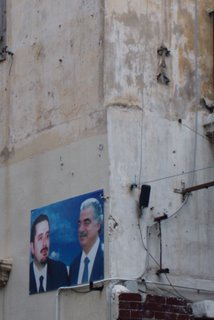
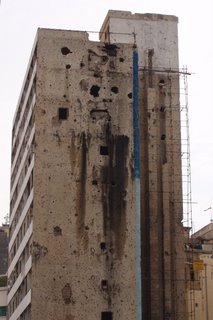
 A large banner depicting assassinated former PM Rafik Hariri, hanging from one of the remodeled buildings. The mosque peeking above the shelled building was a project initiated by Hariri as part of the revitalization of downtown.
A large banner depicting assassinated former PM Rafik Hariri, hanging from one of the remodeled buildings. The mosque peeking above the shelled building was a project initiated by Hariri as part of the revitalization of downtown.